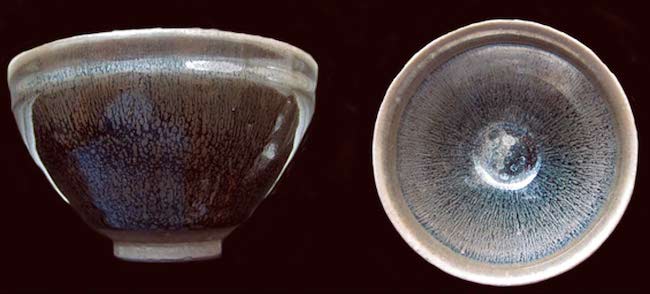We found a story a couple weeks ago about how scientists discovered that the purple glaze famously used on China’s terracotta warriors eliminates one of its dimensions when exposed to extreme cold and magnetism.
Above image: A Jian bowl.
Following that, we found another story that makes us wonder what, exactly, Chinese potters working about a 1,000 years ago were on to with regard to magnetism. Apparently extremely-rare specimens of Song Dynasty vessels, Jian bowls, contain an equally-rare iron oxide material that has valuable applications for magnetism. Scientists, understandably, are green with envy.
The bowls have brown streaks commonly called “hare’s fur.” They also feature silver, round “oil spot” patterns. The Here’s Sci-News doing the Lord’s work by making technical details accessible to the rest of us:
“Based on colors, it has been assumed that the iron oxides that formed in the ‘Hare’s fur’ patterns were of the mineral hematite, while the ones that crystallized in the ‘Oil spot’ patterns were crystallized as the mineral magnetite.
“However, a new study published in the journal ‘Scientific Reports indicates that this is not the case and the results are astonishing…
“Combining different approaches including optical microscopy, electron microscopy, Raman spectroscopy and synchrotron x-ray techniques, the team showed that the crystals contained in the ‘Oil spot’ Jian bowl glaze and responsible for the silvery patterns consists of a high purity ε-Fe2O3 phase (the epsilon phase), a very rare and metastable relative of the mineral hematite.”
How can learning more about these strange bowls benefit us?
“The surprise of the scientists is legitimate as the elusive epsilon-phase has only been identified in 1934 and its crystalline structure was unknown until 1995 and only fully understood in 2005.
“What makes this compound technologically so interesting is that in 2004, it was discovered to have a giant coercivity value of some 20,000 Oersteds. Coercivity is a measure of the ability for a material’s magnetization to withstand changes induced by an external magnetic field, and thus is an important property for the usefulness of permanent magnets.
“The coercivity value for the epsilon phase is more than twice the value of materials currently used in electronic storage media and magnetic stripe cards (i.e credit cards), such as barium hexaferrite BaFe12O19.
“Moreover, there are reasons to believe that the epsilon phase is magnetoelectric, i.e. its magnetic property can be influenced by an electric current and vice versa.
“This is interesting in applications where one wants to change an electric current by a variable magnetic field, such as very compact and energy-efficient electronic components. The fact that it only contains two elements, iron and oxygen, both of which are found in abundance on earth, makes the prospect of wide scale applications of the epsilon phase economically very attractive.
“But there is one big problem: it is very hard to make.”
Modern techniques of producing this material usually only result in itty bitty crystals that all contain imperfections and contaminants from the process. And yet, potters working generations upon generations ago made this material using nothing but glazes and a kiln. Researchers are studying how this was done in the hope that we can learn more about producing this material for ourselves.
Bill Rodgers is a Contributing Editor at CFile.
Any thoughts about this post? Share yours in the comment box below.

A close-up of the glaze that has researchers scratching their heads.

Add your valued opinion to this post.